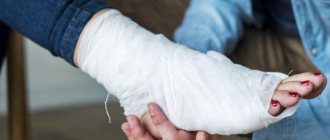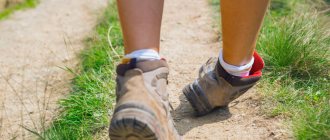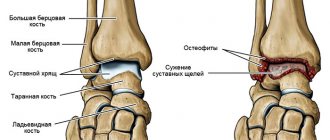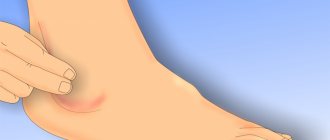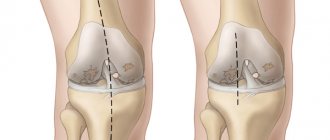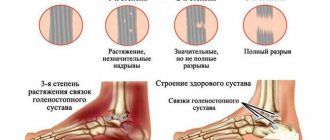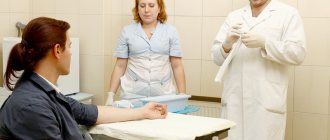A sprain is a common injury characterized by micro-tears of fibers or individual parts of the ligament. It often occurs in standard everyday situations, for example, when twisting a leg. Most often observed in athletes and people leading an active lifestyle.
Symptoms of a sprain depend on the stage of the pathological condition. In any case, at the moment of injury, sharp pain occurs. It intensifies when trying to use the affected limb and subsides a little during the period of repose. Sometimes, when stretched, a characteristic pop is heard - this indicates the rupture of most of the fibers. At the first stage of the pathology, slight swelling forms, movements are somewhat limited, and pain is moderate. In the second, bruising appears, swelling is greater, movements are painful and limited, and support on the injured leg is difficult. The third stage is characterized by significant swelling, multiple bruises, instability of the joint, severe limitation of movement and the inability to lean on the leg.
Symptoms of a sprained ankle
Injuries of 1st and 2nd degrees are partial micro and macro ruptures of soft tissue structures.
When severely affected, they tear off the bone, causing the leg to completely lose functionality. When an ankle sprain occurs, pain of varying intensity occurs, regardless of the degree. Due to the high permeability of blood vessels and pressure on the capillaries, swelling forms and pain increases. If the ankle is sprained, damage to the walls of large vessels occurs, a hematoma appears with blood filling, and the skin becomes blue-purple. If measures are not taken, an inflammatory process develops - ligamentitis, which affects the tendons. The patient may hear sounds similar to clicks when moving or moving his fingers, caused by loss of integrity of the annular ligament.
Orthopedic doctor Alexey Yurievich Moiseenko comments
Sprained ligaments extremely limit the range of rotation and mobility. At grades 2 and 3, it is almost impossible to step on your foot. With complete separation of solid tissue structures, abnormal joint activity is observed.
Stages of rehabilitation
In case of a serious sprain, the doctor prescribes comprehensive treatment to alleviate the victim’s condition and speed up the recovery process. Medicines, physical therapy, and physiotherapeutic procedures are prescribed. The duration of treatment depends on the degree of injury, the age and health of the patient, as well as whether first aid was provided after the injury.
Medicines are prescribed to reduce pain and get rid of swelling. As a rule, doctors prescribe pain-relieving ointments and anti-inflammatory drugs. After the swelling subsides, local warming drugs are prescribed. Therapy is supplemented with angioprotectors and absorbable ointments.
To improve the circulation of blood and lymphatic fluid, as well as speed up recovery and prevent complications in the form of accelerated tissue fusion, lameness and other negative consequences, the following physiotherapy procedures are prescribed:
- cryotherapy;
- electrophoresis;
- ultrasound;
- UHF;
- magnetic currents;
- amplipulse therapy.
A traumatologist or physiotherapist will determine the duration and number of procedures.
Causes
The main etiological factors are sprain or strain due to excessive load on the ligamentous apparatus of the joint, which causes stretching or rupture of the ligaments. Overstrain occurs due to repeated microtrauma of soft tissue structures, disrupting local capillary microcirculation with changes in the structure of the fibers. The problem is accompanied by infiltration (penetration) of fluids and cellular elements into the tissue.
| Mechanism of ankle ligament injury. Scheme |
Sign up for treatment
Partial ruptures of connective fibers occur due to improper foot position, household and sports injuries. About 20% of people whose activities require standing for a long time complain of relapses. Among athletes, the number of joint injuries reaches 50%.
- When the sole is tucked towards itself, the talo-tibial soft tissue structures are affected.
- Eversion often results in a sprain or fracture in the medial malleolus or head of the fibula below the knee.
- Rolling up the outside of the foot injures the lateral group, which restrains excessive supination of the ankle.
- When the leg is fixed and the center of gravity is shifted forward at the moment of flexion of the lower leg, the Achilles tendon suffers.
Occasionally repeated injuries disrupt the stability of the joints, ultimately leading to wear and tear of the bone tissue.
In addition to traumatic causes, there are also degenerative ones that arise due to physiological changes. With age, due to low collagen production, the structural density and elasticity of the fibers decrease. Microtraumas and infections, deforming loads lead to inflammation and the appearance of growths on the bones - osteophytes.
Based only on the symptoms of an ankle sprain, it is impossible to make a conclusion about the patient’s condition. A differential diagnosis is needed to exclude dislocation and intra-articular fracture. In the absence of certain informative measures that determine the degree of rupture and the lesion, it is easy to make a mistake in choosing a treatment method.
Diagnostics
Before treatment for a sprained ankle begins, the patient is sent for an x-ray. Pictures in two projections with an extended and bent lower limb help to form a clinical picture. To assess the stability of the talofibial fibers, the traumatologist performs a test in parallel. One hand creates resistance when moving the ankle, the other holds the heel and moves it forward. To determine problems of the fibula, avulsion fractures of the metatarsal and talus bones, more informative diagnostics are used.
Ultrasound examination
Using high-frequency waves, specialists detect areas involved in the pathological process. On the monitor you can see signs of an ankle sprain:
- Thickening of the ligament, loss of echogenicity in the fatty tissue - the ability to reflect acoustic sound over a certain period of time.
- With partial injury, a hematoma and swollen tissue are clearly visible.
- When a complete rupture occurs, fluid is present in the tendon sheath. In this case, there are disturbances in the movement of the fibers, their intermittency is visible. There is a lot of effusion in the synovial capsule.
- With an old injury, damaged connective tissue and fibrous areas are visible.
If an ankle sprain does not go away for a long time, soft tissues are additionally scanned. This allows you to determine the condition of the fibrous capsule, blood vessels, bone surfaces, and the volume of effusion.
Magnetic resonance scanning
It is prescribed when it is not possible to differentiate the pathology by other methods. It shows:
- condition of the tendons after a sprain in the ankle joint:
- fractures;
- bleeding in the joint (hemarthrosis);
- inflammation;
- arthrosis destructive-dystrophic changes;
- purulent infections and other pathologies.
First aid
At the first symptoms of an ankle sprain, the leg should be immobilized and elevated. Apply crushed ice in a towel or a cold heating pad to the swelling for no more than 15 minutes several times a day, otherwise the effect will be the opposite. To avoid further trauma, the joint is stabilized with an elastic bandage or neoprene bandage, orthosis, or taping.
Orthopedic doctor Andrey Sergeevich Litvinenko comments
In the first week, with grade 1 and 2 sprains, active loads are excluded; thermal procedures and massage are avoided for 3 days. They will provoke hemorrhage and increase the size of the swelling.
Ointments with anti-inflammatory formulas
Along with cold, when a sprained ankle occurs, the acute condition is relieved with local remedies with different active ingredients:
- with propionic acid - Ibuporfen, Nurofen, Deep Relief;
- phenylacetic - Diclak, Ortofen, Voltaren, Diclovit;
- indolylacetic – Indovazin, Indomethacin-Acri;
- with ketaprofen - Fastum, Ketonal, Artrosilene;
- drugs from the oxicam group - Piroxicam - Final gel;
- analgesics - Nimesulide, Nise.
Due to the risk of side effects, ointments are not recommended for long-term use. To relieve pain and treat ankle sprains, painkillers in tablets, non-steroidal drugs are prescribed: Troxevasin, Nimesil, Ketanov, Diclofenac-akos, Movalis, Flexen. Medicines are effective for overexertion and acute conditions.
For chronic processes, corticosteroid injections are prescribed. They block the pain, but do not provide a complete cure. Long-term use reduces collagen production and tendon strength during stretching. Administration is justified only when used once every 2 weeks.
Decongestants
To improve tissue nutrition in the affected area, anticoagulants are prescribed.
- Troxevasin, with its angioprotective effect, reduces the area of edema and the risk of secondary lesions of soft tissue structures.
- Heparin ointment, after entering the systemic circulation, resolves hematomas, effectively relieves swelling when the ankle joint is sprained, and prevents the formation of blood clots at the site of vascular damage.
- Lyoton gel with a high concentration of heparin, in addition to all the listed actions, inhibits the catarrhal process.
Warming ointments for the treatment of ankle sprains
In the acute period, the use of locally irritating drugs is prohibited. They are recommended to be used after 3-4 days to accelerate local blood flow and metabolic processes.
- Capsicum with camphor and gum turpentine warms up and relieves pain for 12 hours.
- Apisatron with bee venom increases the elasticity of the ligamentous muscles.
- Comfrey with tannins, allantoin, vitamin E activates nerve endings and reduces pain.
Chondroprotectors for joints
To prevent the development of degenerative processes in the capsule, chondroprotectors are prescribed for inflammation. Due to the inclusion of mucopolysaccharide and chondroitin, the drugs give a good effect:
- relieve swelling;
- stimulate metabolic processes in bone tissue;
- restore elasticity to soft tissue structures;
- accelerate the production of protein structures, hyaluronic acid, proteoglycan, intra-articular fluid;
- relieve inflammation.
This group includes: Artra, Teraflex, Alflutol, Chondroguard, natural remedies - Mucosat and Toad Stone.
What does "pull your back" mean?
The mobility of the spine is ensured by the paravertebral muscles, ligaments and tendons, which are able to withstand fairly high loads. But if these loads turn out to be excessive, fiber rupture occurs, often accompanied by subluxation of the vertebrae and pinched nerve endings. The rupture can be complete or partial, and depending on this, the clinical manifestations have different severity.
You can strain your back not only when lifting heavy objects, but also when falling, playing sports or during agricultural work.
Table. Degrees of stretch
| Degree | Characteristic manifestations |
| Lightweight | A slight aching pain occurs at the site of injury, which gradually subsides on its own if the person is at rest. There are no other symptoms and this injury does not require treatment. |
| Average | There is severe pain in the back, which intensifies with body movements. The pain syndrome is accompanied by muscle spasms, sometimes accompanied by sensory disturbances in the affected area. Treatment is carried out on an outpatient basis. |
| Heavy | There is acute excruciating pain that intensifies with the slightest movement. Swelling, redness, and bruising may be observed in the affected area of the back. The patient needs complex treatment (often requiring hospitalization), the recovery period can last up to six months. |
The lack of adequate treatment in severe cases leads to the development of many complications and immobilization of the patient.
Condition of ligaments during sprain
What measures are taken in case of severe damage?
In case of a complete rupture, patients are hospitalized, the leg is immobilized, and complex therapy is prescribed, including physiotherapy and exercise therapy. To treat a severe ankle sprain with accumulation of blood in the joint, a therapeutic puncture is performed and the fluid is removed. This measure speeds up rehabilitation and reduces the risk of inflammation.
The leg is immobilized for a month, after removing the plaster, an 8-shaped bandage is applied at a 90º angle of the foot for another 4 weeks. It stabilizes the joint and protects against similar injuries. At the same time, rehabilitation measures are carried out. It takes about 3 months to restore the functionality of the leg.
When is surgery needed?
If, when the capsular-ligamentous apparatus of the ankle joint is damaged, the tibiofibular syndesmosis, a fibrous joint of 3 ligaments connected by connective tissue, diverges, then surgery is indicated. This happens when the distance between the tibia and fibula shortens. This is rare, since a syndesmosis injury is usually associated with a tibial fracture. In this case, the bones are connected with a screw for 2 months, and the ends of the fibers are sutured.
For diagnosis and treatment, minimally invasive arthroscopy is performed under local anesthesia. The technology consists of performing 2 skin punctures. Through small holes, tissue growths, osteophytes, and excess fluid are removed with a special tool. After surgical measures, light loads are allowed after 10 days. To avoid muscle atrophy, they begin to develop the joint according to the program proposed by the traumatologist. Doctors do not recommend choosing exercise therapy exercises on your own. The complex includes: walking on the toes and plantar arches, cross-stepping, climbing stairs, rotations with different amplitudes.
Prognosis and prevention
In most cases, with timely and competent first aid, sprains go away without leaving a trace with complete restoration of the functionality of the joint. The duration of recovery is also influenced by the child’s age, the presence of connective tissue pathologies, and the quality of compliance with medical recommendations.
To avoid sprains and other injuries, experts advise:
- choose high-quality shoes for children with thick soles, thick arch support and good foot support;
- do not allow children to wear excessively high and thin heels, shoes with slipping soles and unstable configurations;
- do not allow sports, dance and other activities with insufficient experience without adult supervision;
- teach children the rules of safe behavior on roads and playgrounds;
- prevent dangerous diving in reservoirs and swimming pools, explaining to children the likely risks of serious injury.
It is also advisable to teach children first aid for sprains, bruises and other injuries, which will help them remain calm in stressful situations and provide proper emergency care to themselves or others.
Physiotherapy
If the ankle is sprained, UHF therapy is prescribed. Alternating currents dilate blood vessels and accelerate regenerative processes.
- The effect of ultrasound is comparable to micromassage. The technology relieves inflammatory reactions and reduces the sensitivity of nerve receptors in the affected area.
- Paraffin applications have an analgesic and stimulating effect.
- Alternating different-frequency currents in diadynamic therapy is used for pain blockade.
- Hardware massage enhances the effect of procedures, relieves muscle spasms, and improves nutrition of soft tissue structures.
